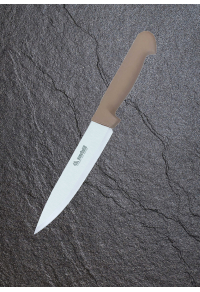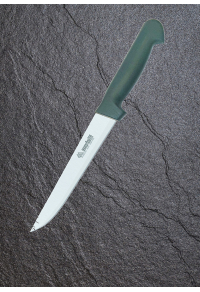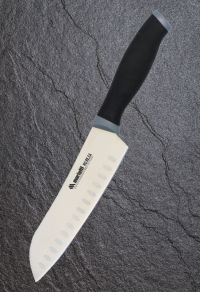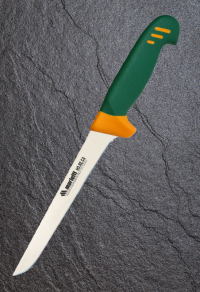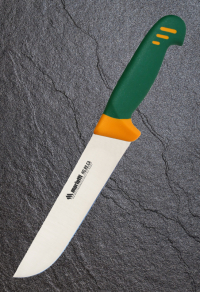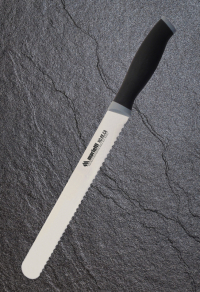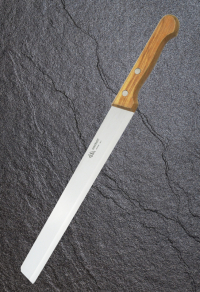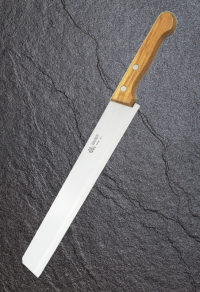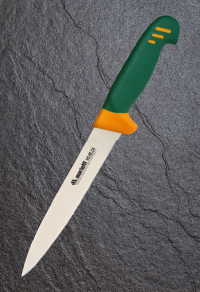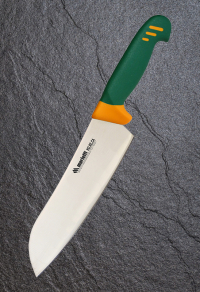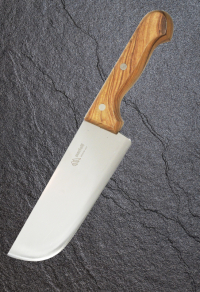Home
Subcategories
-
copy of Knife CUCINA -...
Together with the knife for vegetables it is probably the most used, as it can be used on a wide variety of foods and for a long series of operations. For example, it is able to chop, chop, reduce into cubes and slice meat, fish and vegetables.
-
copy of Knife DISOSSO -...
In the kitchen we often find ourselves working cuts of meat of different sizes and we need to separate the bones from the meat. DEBONING knives cater to this need: they can have a STRAIGHT or slightly CURVED blade to absorb the different types of cuts and shapes of the animals, making the preparation of the meat easier.
-
Knife SANTOKU 1235TP
A Santoku has a blade quite similar to a carving knife and is the Japanese equivalent of a chef's knife. Since it is a good idea to have a knife (and a cutting board) for raw food and a knife (and a cutting board) for cooked foods, the second carving knife can be a Santoku so you have the chance to try this type of blade too. The big difference between the two blades is that the carving knife is designed so that the tip always remains in contact with the cutting board, while the Santoku is used as a small cleaver and the tip always comes off the cutting board.
-
Knife DISOSSO 18 BON18
In the kitchen we often find ourselves working cuts of meat of different sizes and we need to separate the bones from the meat. DEBONING knives cater to this need: they can have a STRAIGHT or slightly CURVED blade to absorb the different types of cuts and shapes of the animals, making the preparation of the meat easier.
-
Knife FRANCESE 18 BUT18
Knife with a large and heavy blade, generally having a length between 15 and 30 cm with a specific curvature - near the tip - that allows precise cuts to be obtained. Used to cut all types of red meat. -
Knife PANE 1244TP
Slicing bread precisely and serving beautiful slices is a daily action. In addition, cakes, casseroles, roulades and other savory or cheesy preparations require a precise cut without having to pressurize the food, and this blade facilitates cutting.The tip is not needed and the blade must be wavy so as to incise the crust slowly without breaking it.
-
Knife SALUMI
Very important for slicing meats and hams and salmon if it has a blistered blade. They have a long (possibly hollow) and very flexible blade. -
Knife PASTA
The type of knives with SMOOTH blades table are suitable for fruit, vegetables and fish (cooked or raw). Sharp and flexible, together with the fork they are a true ally of the palate -
Knife FILETTARE 18 FIL18
To "fillet" a thin and very well sharpened blade is needed, better if quite flexible. While it is being withdrawn, it is really necessary to have a flexible blade and let it slide without using excessive pressure. Type of knife and relative blade dedicated almost exclusively to the preparation of fish. Think of cleaning all medium and large fish, when you intend to remove the "pulp" from the spine.
-
Knife SANTOKU 18 STK18
The Santoku knife represents the Japanese equivalent of the European chef's knife (CHEF KNIFE). Characteristic Japanese knife used to cut and chop vegetables. For this operation - in fact - Western cooks use the knife called CHEF KNIFE The big difference between the two blades is that the carving knife is designed so that the tip always remains in contact with the cutting board, while the Santoku is used as a small cleaver and the tip always comes off the cutting board.
-
Knife CUCINA - cod. 132A
Together with the knife for vegetables it is probably the most used, as it can be used on a wide variety of foods and for a long series of operations. For example, it is able to chop, chop, reduce into cubes and slice meat, fish and vegetables. -
Knife PESTO
Butcher knives have large and heavy but also very sharp blades. They are also generally used as chippings, but they are also very useful for cutting meat slices and pieces.


